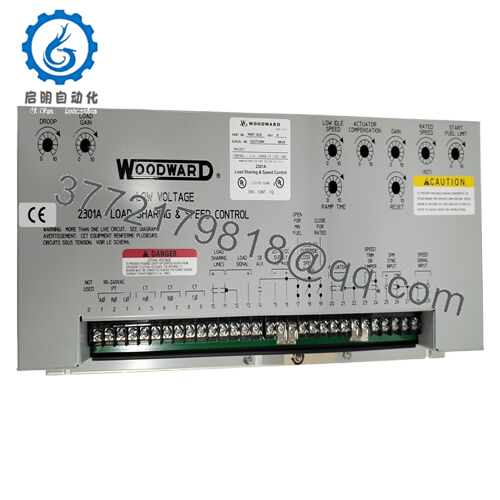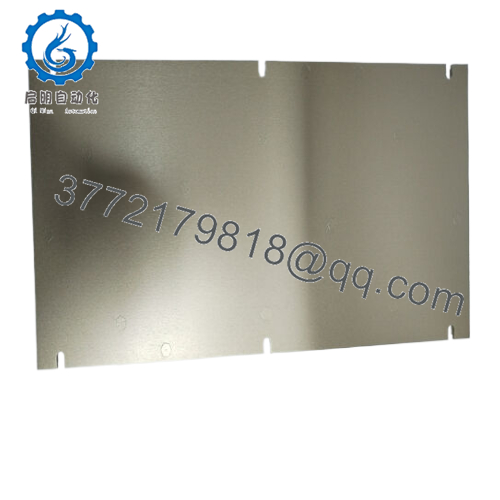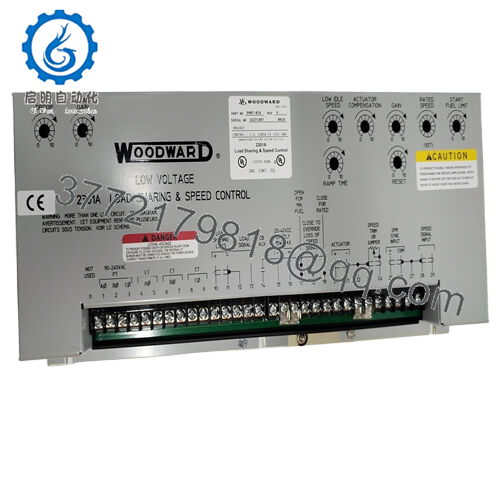Description
Product Model: 9907-018
Product Brand: Woodward
Product Series: 2301A (Load Sharing & Speed Control)
Product Features:
- Electronic module providing speed control in isochronous or droop modes and load sharing among parallel units
- Low-voltage version (20–40 V DC) with actuator output up to ~200 mA
- Switch-selectable speed ranges (500–1500 Hz, 1000–3000 Hz, 2000–6000 Hz, 4000–12000 Hz)
- Supports external droop/isochronous switching, synchronizer input, CT/PT measurement, start-fuel limiting, gain, compensation tuning
Main Article
Below is the in-depth product article. Sections are reordered to maintain freshness; the 9907-018 term is sprinkled naturally (8–11 times).
Product Role & System Fit
The 9907-018 is a load-sharing and speed control module from Woodward, part of the 2301A family of governor / load share devices. It is intended to control engine or turbine speed and also coordinate load distribution among parallel machines. In a control architecture, the 9907-018 sits between the speed sensor, CT/PT measurement circuits, actuator output, and external synchronizer or load-matching modules.
In typical installations, you’ll find one 2301A control per prime mover (diesel engine, gas turbine, steam turbine) in a multi-unit generator set. Each unit’s 9907-018 monitors its own generator’s load (via current transformers), senses speed, and contributes to a load sharing bus with other units so that load changes are shared proportionally. It can also operate in isochronous mode (maintaining constant speed) when desired.
Because the 2301A supports interface with a synchronizer (SPM-A) via speed/phase input terminals, the 9907-018 often works in tandem with a synchronizer module: matching frequency and phase before closing breakers, then handing control back to load share logic.
The low-voltage variant (20–40 V DC) of the 2301A covers many genset applications; the same family also supports higher-voltage versions. In retrofit or hybrid systems, the 9907-018 is sometimes inserted into existing control racks or used to replace older analog governors, preserving field wiring and actuation systems.
In operation, each module enforces speed control. In parallel, the load sharing network ties the units together. The 9907-018’s built-in tuning controls (gain, compensation, droop, ramp, start fuel limit) allow tailoring to each prime mover’s dynamic behavior.
Applications & Industry Context
Systems with multiple generators—such as utility plants, data centers, marine power plants, remote power stations, microgrids, or standby power installations—require reliable control of speed and load sharing. The 9907-018 (2301A) module is well suited to such environments.
In a data center or hospital, redundant gensets must synchronize smoothly and share load in the event of demand swings. The 9907-018 ensures that when the breaker is closed, the new unit’s speed matches, and then it participates equitably in load sharing. In islanded microgrids, precise control is essential to prevent unit hunting or overloading.
In marine or offshore settings, vibration, electrical noise, and load transients are common. Engineers often choose robust controls like the 2301A family because they allow for resistor-shielded wiring, selectable tuning, and durable design.
Refineries, chemical plants, or remote petroleum installations deploy multiple turbines or reciprocating engines in parallel; using 9907-018 modules allows consolidating load control logic while preserving modular redundancy.
In retrofits, replacing aging analog droop governors with 9907-018 modules is a frequent project: it modernizes control logic, improves tuning flexibility, and integrates with networked synchronization equipment (SPM-A or others). The modularity and front-access potentiometers make field tuning feasible without removing the unit from the rack.
Technical Features & Benefits
Let’s dive into the features and benefits that make 9907-018 a strong choice.
Isochronous / Droop Modes
The 9907-018 supports both isochronous (constant speed) and droop (speed decreases with load) operation. You can wire an external droop contact (terminal 14/16) to switch modes. In isochronous mode, the internal load sharing relay is energized and the droop effect is disabled; in droop, the load sharing lines are disabled.
Wide Speed Range Selection
Switches on the control module allow selecting from four speed ranges: 500–1,500 Hz, 1,000–3,000 Hz, 2,000–6,000 Hz, or 4,000–12,000 Hz (factory default is often 2,000–6,000 Hz). ❗ Choosing the wrong range can lead to overspeed conditions—care must be taken.
Actuator Output & Compatibility
The 9907-018 supports actuator currents up to ~200 mA (for the 0–200 mA version) to drive proportional actuators. It can be configured forward or reverse acting, and supports tandem (dual actuator) or single actuator configurations.
Power Supply & Consumption
For low-voltage variants, the module expects 20–40 V DC supply; high-voltage versions accept 88–132 VAC or 90–150 V DC. Power consumption is ≤ 15 W nominal.
Gain, Compensation, Ramp, Start Fuel Limit
All the tuning controls (gain, actuator compensation, reset, ramp time, start fuel limit, low idle) are accessible from the front. This lets technicians fine-tune control behavior in situ.
Load Sensing & Load Sharing
To share load among parallel units, each 9907-018 monitors generator current (via CT inputs) and outputs a load voltage (0–6 V DC). Matching the load gain potentiometers ensures proportional sharing. The module includes a built-in load matching circuit.
Synchronizer Input (SPM-A support)
Terminals 25–26 permit an external synchronizer (SPM-A) to inject a speed/phase bias, facilitating seamless breaker closure.
Environmental & Mechanical Specs
Rated operating temperature is from –40 °C to +85 °C. The control is enclosed in sheet-metal chassis. It can tolerate vibration and shock typical of engine rooms. Weight is about 1.8 kg (4 lb) for low-voltage models.
Certifications & Compliance
The 2301A 9905/9907 controls are CSA-certified for ordinary locations in the U.S. and Canada. The 9907-018 is marked CE in appropriate markets.
In practice, these features mean reliable parallel operation, responsive control over load changes, and flexibility in tuning across a wide set of generator/engine types.
- 9907-018 2301A
Installation & Maintenance Insights
Here’s practical advice for installing, commissioning, and maintaining the 9907-018 (2301A).
Mounting & Wiring Location
Install the unit in a control cabinet, away from high-voltage devices, strong heat sources, or heavy vibration. Provide ventilation and space for front-panel access to potentiometers. Do not mount directly on the engine.
Signal Wiring & Shielding
Use twisted, shielded cable for PT, CT, and speed sensor lines. The shield should be grounded at only one end, per the wiring guidelines in the manual (Figure 2-1). Keep signal wiring separate from power wiring to prevent interference.
Supply Wiring
Run the power supply leads directly to terminals 16 (+) and 15 (–). If DC battery-supplied power is used, ensure a charging source (alternator or regulated supply) to maintain stable voltage. Always verify polarity before applying voltage.
Setting Speed Range & Calibration
Set the speed range switch correctly before powering. Incorrect setting may lead to overspeed conditions. Use the rated-speed potentiometer and trim circuits. Mark factory positions before making any adjustments.
Droop / Isochronous Switching
Wire an external droop contact between terminals 14 and 16. The status of this contact (and the generator breaker auxiliary contact) determines whether droop or isochronous mode is active.
Load Sharing Bus Wiring
Connect load sharing lines between all units via shielded wiring. Avoid grounding the shield in multiple places across modules. Consistency matters. Ensure all 2301A units share the same load gain settings for proportional sharing.
Commissioning Steps
- Power up and verify sensor readings (PT, CT, speed)
- Set base speed and trim to match desired generator frequency
- Adjust gain and compensation to achieve stable transient response
- Test load sharing: increment load and verify units share properly
- Insert synchronizer (SPM-A) test to confirm phase matching and breaker control
- Validate the switching between droop and isochronous modes
Maintenance & Periodic Checks
- Inspect terminal wiring for tightness and corrosion
- Clean internal parts if dust accumulates
- Periodically re-check calibration (gain, compensation) especially after engine overhauls
- Monitor logs or alarms if present
- Keep a spare 9907-018 or identical 2301A unit on hand; document settings for quick swap
Troubleshooting Guidance
The manual includes a troubleshooting table (Table 5-1 in 82389) covering symptoms like no speed signal, actuator non-responsive, improper load sharing, etc. Follow those step-by-step diagnostics before opening the module.
Use extreme care when replacing or configuring—miswiring or overspeed conditions can cause serious equipment damage or safety hazards.
Technical Specifications Table
| Parameter | Value / Description |
|---|---|
| Module Type | 2301A Load Sharing & Speed Control (9907-018) |
| Supply Voltage | 20–40 V DC (low-voltage version) |
| Power Consumption | ≤ 15 W |
| Speed Range Options | 500–1500 Hz, 1000–3000 Hz, 2000–6000 Hz, 4000–12000 Hz |
| Actuator Output | Up to ~200 mA (depending variant) |
| Gain / Compensation Adjustments | Front-panel potentiometers for gain, reset, actuator compensation, ramp, trim, low idle, etc. |
| Load Sharing Output | 0–6 V DC load sensing voltage |
| Synchronizer Input | Terminals 25–26 support SPM-A input |
| Operating Temperature | –40 °C to +85 °C |
| Vibration / Shock | Designed for engine-room conditions (typical specs in manual) |
| Weight | Approximately 1.8 kg (4 lb) |
| Enclosure / Housing | Sheet-metal chassis, front-access potentiometers |
| Certifications | CSA (ordinary locations), CE marking on appropriate units |
Related Models & Alternatives
- 9907-019 (2301A) — reverse-acting variant of the same control class
- 9905-0xx (2301A low-voltage series) — other part numbers in the same family with different current ranges or tandem support
- SPM-A synchronizer modules (e.g. 9905-002) — used in conjunction with the 2301A load sharing controls
- More modern digital load share / paralleling controllers — as upgrades in newer genset systems
- Alternate speed/load controls from other OEMs — for hybrid or mixed-brand systems
When migrating or upgrading, ensure compatibility of speed ranges, actuator interface, and load sharing logic.




 WhatsApp: +86 16626708626
WhatsApp: +86 16626708626 Email:
Email:  Phone: +86 16626708626
Phone: +86 16626708626


